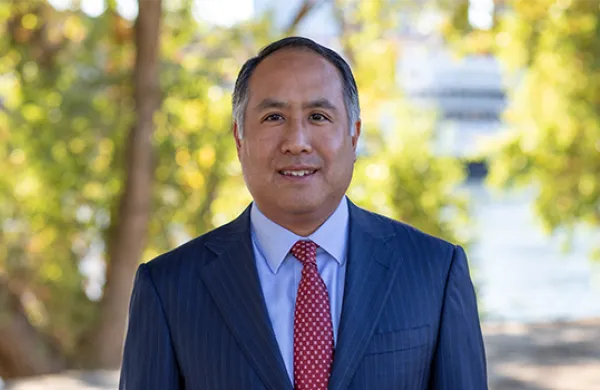In late 2013, FTSE Russell’s Kevin Bourne and several colleagues flew to California to get the two biggest U.S. public pension funds’ take on what his firm believed might be a transformative approach to sustainable investing.
Bourne, head of databases for the London-based index provider, met with representatives of the $193 billion California State Teachers’ Retirement System and the $304 billion California Public Employees’ Retirement System. Among those present at the former’s West Sacramento offices: CalSTRS chief executive Jack Ehnes and Anne Stausboll, then his counterpart at CalPERS.
FTSE Russell demonstrated its LCE (for Low Carbon Economy) data model, which measures green revenue, or the proportion of a company’s sales from products and services that help to solve environmental problems. The model tracks 13,400 public corporations representing 98.5 percent of total capitalization in 48 countries, giving each one a green revenue score.
Bourne showed the pension executives what seven years of preliminary data revealed: The overall proportion of green revenue was growing. For FTSE Russell, this confirmed his hypothesis that the corporate world has embarked on a shift to a low-carbon economy.
“At the meeting I remember everyone reflecting, ‘Wow, this is stuff we need to be thinking about, and we don’t have the data tools,’” says CalSTRS’s Ehnes, who also chairs the FTSE Environmental Markets Advisory Committee and sits on the FTSE Russell Environmental, Social and Governance (ESG) Advisory Committee.
That changed this June, when FTSE Russell publicly released its LCE model along with the FTSE Green Revenues Index Series; the latter comprises ten indexes, each focused on a different market.
CalSTRS’s corporate governance staff is looking at ways to use the green revenue data to hone engagement efforts with companies, Ehnes explains. But more difficult, and potentially more exciting, he notes, is thinking about how tracking such revenue at the company or industry level could help the pension plan to make investment decisions.
For CalSTRS, such questions are part of a broader sustainability push when it comes to direct investments. In July, for example, the plan announced that it was committing $2.5 billion to a low-carbon equity index strategy. Ehnes wants to complement that measure of greenness with other metrics.
Despite its name, the LCE model looks beyond companies’ carbon emissions. As FTSE Russell’s Bourne points out, there are already data providers and investment strategies that quantify such output, along with ESG performance when it comes to, say, the number of women on a corporation’s board. But he noticed a gap.
“The question that had been left alone is what companies manufacture, and are those products solving the problems we’ve created over the past 250 years of industrial development?” Bourne says. “We couldn’t find anyone who had built the data model that fit in that box.”
The LCE model tracks green revenue by starting with the 60 subsectors listed in FTSE Russell’s new Low Carbon Economy Industrial Classification System. This industrial taxonomy includes business efforts around ocean desalinization, flood control, erosion prevention, renewable energy and technologies that shrink the carbon output of the aviation, road vehicle and shipping sectors.
Researchers and algorithms sift through audited accounts and other public domain data to determine the percentage of a given company’s revenue across any green industries in which it operates. The model then adds up that green revenue and calculates its proportion to total revenue. Of the 13,400 corporations LCE follows, Bourne says, roughly 2,600 generate green revenue.
Since the launch of the model and its related products, the greatest client demand has been for the data itself, he observes. FTSE Russell is also seeing growing appetite for custom indexes and trading models built using that information, Bourne says.
LCE is the first publicly available tool for quantifying green revenue, but Boston-based Trillium Asset Management has been making similar calculations in-house since 2008. CEO Matthew Patsky says that for his $2.2 billion firm, such data has become crucial when deciding which businesses are clean enough to invest in. Trillium’s portfolio companies must derive at least 25 percent of their revenue from tackling environmental problems, and that proportion must be increasing relative to total revenue.
Many of the firms using the LCE data — 170 major financial institutions took part in the model’s 18-month trial run, and others have since signed on — are doing something similar by finding ways to isolate the companies whose green revenue is growing faster than that of the rest of the business, Bourne says.
He also notes that for the 13,400 corporations the LCE model follows, green revenue growth is the overall trend: Over the past eight years, the number of companies generating such revenue has climbed almost every year, after starting at less than 2,100. The absolute value of green revenue also rose during that time.
There are some holes in the data. Of the 2,600-odd companies generating green revenue, about one third don’t disclose precise numbers for those lines of business. When the value is inaccessible and FTSE Russell can’t calculate a green revenue percentage, a given company’s green revenue score stays at zero. If a corporation’s possible green revenue percentage falls within a range, the LCE model will assume the lowest number. “We’re being conservative until a company’s disclosure improves,” Bourne says.
To supplement the model released in June, FTSE Russell will soon build one that makes green revenue estimates. Over time, companies will become more transparent and correct the estimates where called for, Bourne believes.
When asset managers and risk officers see the story LCE data is telling, there’s an “epiphany,” he says: “They suddenly realize that there’s this unobserved structural change in industrial output taking place, and it can now be measured and modeled.”
Get more on pensions.






